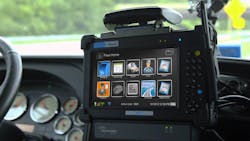Whether fleets and drivers like electronic logging devices (ELDs) or not, they must add them to their vehicles by mid-December 2017; that’s the law.
Yet for those fleets not already using ELDs, Daniel Brown, risk control technical manager for insurance firm Travelers, said complying with the law boils down to this: Will trucking view it as a costly burden or an opportunity to generate savings?
“The question really fleets need to ask is, what can this technology do for us?” he explained to Fleet Owner. “And it’s really not about the ELD itself. Rather, the device becomes the impetus for a broader discussion.”
Brown noted that fleets are faced with a technological “fork in the road” where the ELD rule is concerned: Do they simply buy the most basic device to comply with the mandate? Or do they invest in more advanced telematics systems that will deliver more information?“Much better solutions deliver more information about what the trucks and drivers are doing: this is what telematics systems do,” he stressed. “Drivers by and large are doing what they should be doing, or no trucking company today would be in business. The next step is gaining information to help them and the fleet operate more efficiently; information that also can be used to protect them both.”
Yet turning the ELD mandate into a “savings opportunity” requires several steps on the part of trucking companies, Brown (at right) emphasized:
- A full year is needed to select the right ELD system if a fleet does not have one. “Don’t be rushed; selecting the right technology alone takes months,” he said. “Evaluate different systems and then allow time for installation and training. For larger fleets this will be a longer process.”
- Getting “buy-in” across the whole company about ELDs, not just the drivers, is critical. “All aspects of a trucking operation will be affected, from maintenance to accounting,” he pointed out. “Get feedback and address concerns from everyone.”
- Don’t use ELDs as a “tattletale.” Brown – a former long-haul driver himself who also worked as a fleet safety director before jumping into the insurance business – said the biggest opportunity for savings lies in the use of data for positive feedback for all of a motor carrier’s drivers. “We always talk about what drivers do wrong but telematics data also shows what they do right,” he stressed. “You need to emphasize that, for it makes good drivers even better.”
- Stress the “protective” value of telematics-enhanced ELD data, especially in crashes. “I haven’t talked to a carrier yet that doesn’t have a story where data exonerated a driver,” Brown noted. “All too often in a crash, a commercial driver is at a disadvantage when it’s their word against everyone else involved. Telematics data – particularly with video recording connected to it – can change that. Drivers really like this aspect.”
- Insurance discounts should not be the primary focus with enhanced ELD systems. “Reducing exposure to accidents and the costs associated with accidents is the main benefit to focus on,” he said. “The goal is the reduction in claims and losses.”
- It’s hard to calculate the exact ROI but it is there. Brown stressed that while the opportunity to improve safety offers the biggest potential savings, others are there, too, such as improved fuel economy and lower maintenance costs due to the improvement in driving habits.
- Continual feedback is the only way to drive savings long term. “The benefits can tail off without continuous feedback,” he explained. “The savings are not automatic; there will be actually little benefit unless that feedback is constantly provided.”
- Use that ELD data to fuel ongoing safety conversations. Brown said one of the “limiting factors” in safety discussions today is a lack of data. “You want to have an ongoing conversation with drivers, but you’re limited in what you can talk about when all you have are accident reports or negative phone calls from the public,” he explained. “Data – especially about good habits – gives a safety director something specific to talk about with each and every driver on an ongoing basis. That allows for good discussions and that positive feedback only helps drivers get better.”
About the Author
Sean Kilcarr
Editor in Chief
Sean Kilcarr is a former longtime FleetOwner senior editor who wrote for the publication from 2000 to 2018. He served as editor-in-chief from 2017 to 2018.

